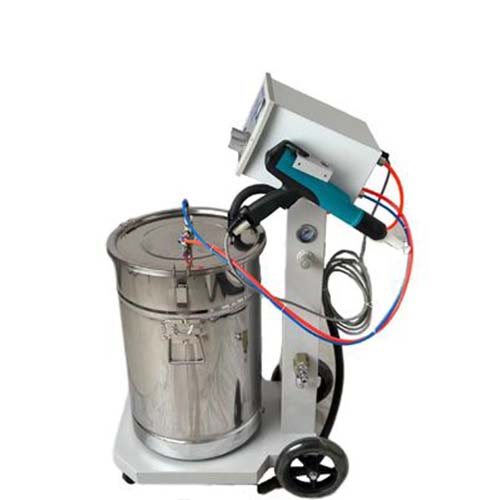Powder Coating Spraying Machine meets demand from DIYers, small metal shops, and auto restorers, valued for durable, smooth finishes. Prices range: home-use models start at $700–$1,300, mid-range units for workshops cost $1,800–$5,000, and industrial machines with high throughput exceed $9,000, based on spray rate and durability.

Powder Coating Spraying Machine suits projects like coating metal gates, refinishing tool chests, or customizing motorcycle parts. It handles items from small hardware (wrenches, keychains) to medium-sized pieces (metal chairs, generator covers), making it ideal for users needing flexibility over mass production. Projects benefit from consistent coverage, even on intricate designs (like latticework or curved handles), reducing the need for post-spray touch-ups.
Powder Coating Spraying Machine uses a precise surface treatment process. First, pre-treat the surface: clean with degreaser to remove oil, sandblast to remove rust, and air-dry—critical for powder adhesion. The machine’s spray gun uses electrostatic charge to propel powder, which clings to the grounded metal (or heat-resistant plastic) surface, ensuring even coverage. After spraying, cure the item in an oven (170–220°C) to melt the powder into a hard, uniform layer. This process avoids drips common with liquid paint, ensuring professional results.
Powder Coating Spraying Machine is a compact system designed to apply dry powder coatings via electrostatic technology. It integrates a powder storage hopper, adjustable spray gun, and control panel in one unit, eliminating the need for separate tools. It operates on standard 110V or 220V power, fitting in garages or small workshops, and is built for users with basic skills, balancing performance and ease of operation.
Electrostatic Spray Gun: The core of Powder Coating Spraying Machine, it delivers charged powder particles. It features adjustable spray patterns (narrow for edges, wide for flat surfaces) and flow rates, letting users control coating thickness—vital for items like metal shelves or bike frames.
Powder Hopper: A detachable container on Powder Coating Spraying Machine holds 1–4 kg of powder. It includes a filter to prevent clogs and a transparent window to monitor levels, ensuring uninterrupted spraying during projects.
Control Panel: Part of Powder Coating Spraying Machine, it adjusts electrostatic voltage (10–90 kV) and air pressure (20–60 psi). User-friendly knobs or digital displays let operators tweak settings for different powders (polyester, epoxy) and substrates, ensuring optimal adhesion.
Powder Coating Spraying Machine offers key benefits. Its finish resists scratches, chemicals, and UV rays, extending the life of coated items. It is eco-friendly, with no volatile organic compounds (VOCs) like liquid paints, reducing environmental impact. Unused powder is recyclable, cutting material waste. Its compact design saves space, and simple setup makes it accessible to beginners. It works on diverse metals (steel, aluminum) and some plastics, boosting versatility.
How to set up Powder Coating Spraying Machine for home garage use?Setting up
Powder Coating Spraying Machine for home garages starts with choosing a well-ventilated area. Place the machine on a stable workbench, connect to a 110V outlet, and ground the work surface with a copper wire. Fill the hopper with 0.5–1 kg of powder (start with a neutral color like black for practice). Adjust the gun to low pressure (20–30 psi) and test-spray a scrap metal piece. Cure in a small oven at 190°C for 15 minutes. Clean the gun and hopper after use to avoid clogs, and store powder in a dry container to prevent moisture damage.
How to fix bubble formation in coatings from Powder Coating Spraying Machine?Bubbles in coatings from
Powder Coating Spraying Machine often result from surface moisture or improper curing. Ensure the substrate is fully dry before spraying—use a heat gun to remove residual moisture from crevices. Check the curing temperature: too high (over 220°C) can cause gas bubbles, so lower to 180–200°C. Avoid thick coats; apply two thin layers (with curing between) instead of one thick layer. If the hopper has moisture, replace powder with fresh stock, as damp powder traps air during spraying.
How to choose Powder Coating Spraying Machine for industrial metal fabrication?Choosing
Powder Coating Spraying Machine for industrial use requires assessing throughput: opt for models with 3–5 kg hoppers and spray rates of 2–4 kg/h to handle large batches. Look for automatic gun adjustment (via sensors) to ensure consistency across 50+ items daily. Prioritize durable components (stainless steel hoppers, brass nozzles) to withstand heavy use. Check curing compatibility—pair with a conveyor oven (instead of batch ovens) for continuous processing. Ensure the machine integrates with existing power systems (3-phase electricity) and has safety features like overload protection.
How to clean Powder Coating Spraying Machine after long projects?Cleaning
Powder Coating Spraying Machine after long projects prevents clogs and extends life. Disconnect power, empty leftover powder from the hopper, and sift it back into its container (discard any clumps). Use compressed air to blow out the gun nozzle and feed tube—focus on the filter, which traps debris. Wipe the hopper with a dry cloth (avoid water) and lubricate the control panel’s moving parts with silicone spray. Check the electrostatic cable for damage; frayed wires reduce charge efficiency. Store the machine in a dust-free area to keep components clean between uses.
How to extend the lifespan of Powder Coating Spraying Machine?Extending the lifespan of
Powder Coating Spraying Machine involves regular maintenance. Inspect the gun nozzle monthly for wear—replace if it shows cracks (worn nozzles cause uneven spray). Calibrate the control panel every 3 months using a voltage meter to ensure accurate settings. Keep the hopper dry; add desiccant packs during humid weather to prevent powder clumping. Avoid overloading the machine—stick to its rated powder capacity (e.g., 1 kg/h for home models). Store in a climate-controlled space (15–25°C) to prevent rust on metal parts. Following these steps can add 5–7 years to the machine’s life.
Links:
 Leave us message
Leave us message

